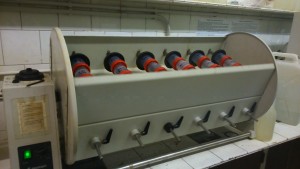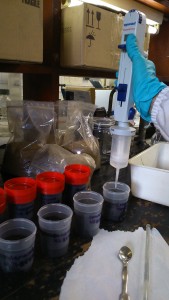This week I started preparing my lab experiment. Monday morning Joan and I headed once again to the forest we went to last week, this time to collect soils from two soil horizons, an organic layer and a mineral layer. We arrived back at the university in the early afternoon and I spent the rest of the day sifting the soils to remove leaves and roots and make them as homogenous as possible. The following days the weighing began…oh, saudade for my assistants in Brazil! Two days of weighing soil samples, (staying until 9pm one day when I had hoped those long days in the lab were finally behind me) made me miss our 2, 3 sometimes more assistants with whom I would have gotten everything weighed in 3 hours. After weighing the soils and adding the biochar, I placed the sealed cups in a rotating mixer so that the biochar would mix thoroughly with the soils, and left them overnight.

The next day it was time to moisten the soils. This again took a few hours, but the automatic pipetter I used was awesome. It was so great to be able to put an exact, precise amount, like 1.8 mL, with just one pipetter and not have to use 3 or 4 different ones to add up like I had to in Brazil, or use less precise glass pipettes.

There are definitely pros and cons to every place you work at. Here, there is a lab technician, Andreu, and he has been super helpful in showing me where things are and how things work. If anything is missing, I can just ask him and he’ll find it or place an order for it. In the labs I worked at in Cuiabá there were unfortunately no technicians so students often had to figure things out on there own, the result being that things were often missing or broken or with a long waiting list. Here, there is no water distiller in the lab, but they have the distilled water delivered to the lab in jugs. There is even an electric pump to pump water into smaller containers for easier use. Amazing! In Cuiabá, the lab I used also didn’t have a distiller so us students had to go to other labs that had distilled water and hope they let us use some. Then we had to lug the jug back to the lab and, in my case, ask a strong student to help me pour it into the container with the tap. That’s the thing though: I had help to carry water. Here, the lab is pretty well-equipped. Everything is in one lab, I don’t have to go searching for beakers in one lab, distilled water in another, and reagents in a third. Everything is in one place. Magical. However, in Cuiabá there were tons of students to help out with the gritty work. Weighing, sifting, collecting, cleaning, carrying, there was usually always someone to help me with tasks. Here, it’s just me. Joan provides everything I need, but then I’m on my own. Of course, it’s a small experiment so it’s perfectly feasible and setting it up on my own means I have more control over it. After all, if things screw up, it’s my fault alone. It’s funny how my experience at the UFMT and here at UB seem complete opposites. I think UBC would be somewhere in the middle: the soils lab is well-equipped and there are always a bunch of students around. Honestly, I think it’s pretty nice that I’ve experienced working in three different labs. Of the three, UFMT was definitely the most challenging, but, boy, do I have some great memories! (Of course, now I can laugh)
So now everything is weighed, mixed, moistened and sitting in the fridge. Next week we will be setting up the cups for incubation and it will be all set to run. For 3 months I will be taking CO2 readings to measure the decomposition rates in the different soils with and without biochar. Hopefully, we will see some responses!